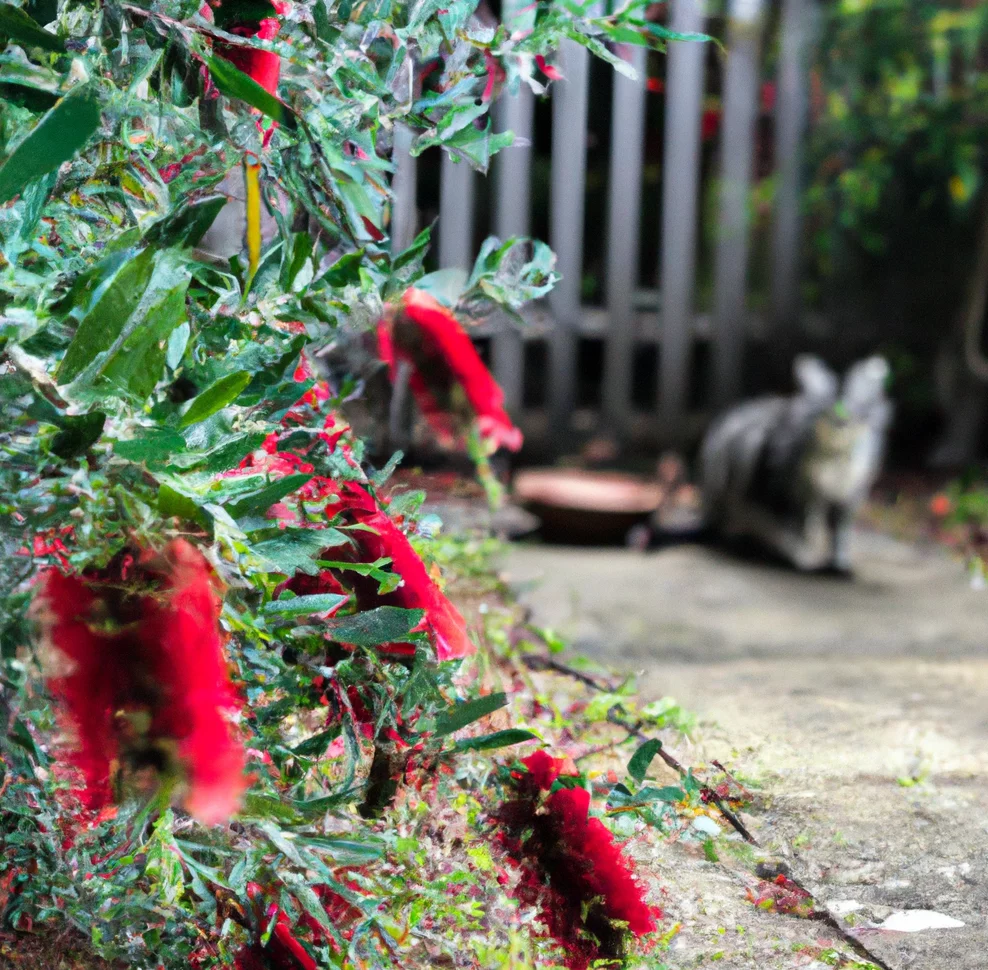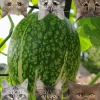Key Takeaways
Bottlebrush trees are non-toxic to both dogs and cats.
Ingesting bottlebrush leaves or flowers may cause mild stomach upset in pets.
No documented cases of bottlebrush-related poisoning in pets exist.
Symptoms to watch for include vomiting, diarrhea, and lethargy.
Training and physical barriers can prevent pets from eating garden plants.
Is It Safe for Dogs and Cats to Eat Bottlebrush?
As pet owners, we always worry about the safety of our furry friends, especially when it comes to the plants in our gardens. One common question is whether bottlebrush trees are safe for pets. The short answer is yes, bottlebrush trees are generally safe for dogs and cats.
“or Callistemon Toxic For Cats …” from plantsncats.com and used with no modifications.
Introduction to Bottlebrush Plants
Bottlebrush plants, scientifically known as Callistemon, are popular for their vibrant, brush-like flowers that resemble a bottle brush. These plants are commonly found in gardens and landscapes due to their striking appearance and hardiness. They thrive in various climates and can be grown as shrubs or small trees.
Appearance: Bright red, cylindrical flowers that resemble a bottle brush.
Common Names: Crimson bottlebrush, weeping bottlebrush, prickly bottlebrush.
Growth Habit: Can be grown as a shrub or small tree, evergreen in nature.
Besides their beauty, it’s crucial to understand the safety of these plants if you have pets that love to explore the garden.
The Basics: Are Bottlebrush Trees Poisonous to Pets?
The good news is that bottlebrush trees are non-toxic to both dogs and cats. According to the ASPCA, there are no documented cases of toxicity related to bottlebrush trees. This means you can let your pets roam around these plants without worrying about severe health risks.
However, like with any plant, there are still a few things to consider to ensure your pet’s well-being. For example, you might want to look into the pros and cons of bottle brush trees if you have pets.
Potential Risks of Bottlebrush Trees for Pets
Non-Toxic Nature of Bottlebrush
The bottlebrush plant’s non-toxic nature means that it does not contain harmful compounds that could endanger your pets. This is a significant relief for pet owners who want to maintain a beautiful garden without compromising their pets’ safety. For more information on the pros and cons of these plants, check out this article on the pros and cons of bottle brush trees for pet owners.
“The ASPCA lists Bottle Brush Tree as non-toxic to dogs and cats.” – Downtoearthdigs
Because of this, you can confidently plant bottlebrush in your garden, knowing that it won’t pose a chemical threat to your furry friends.
Possible Mild Stomach Upset
Even though bottlebrush trees are non-toxic, ingesting any plant material can sometimes lead to mild stomach upset in pets. This is particularly true if your dog or cat decides to munch on the leaves or flowers. For more information, you can read about the pros and cons of bottle brush trees for pet owners.
Common symptoms of mild stomach upset include:
Vomiting
Diarrhea
Lethargy
These symptoms are usually temporary and resolve on their own. However, it’s always a good idea to monitor your pet and consult a vet if the symptoms persist or worsen.
Are Pets Allergic to Bottlebrush?
Another concern some pet owners might have is whether their pets can be allergic to bottlebrush plants. While allergies to bottlebrush are rare, they can still occur. Allergic reactions can manifest as skin irritations, itching, or respiratory issues. For more information on this topic, you can read about the pros and cons of bottlebrush trees for pet owners.
If you notice any of these symptoms after your pet has been around bottlebrush plants, it might be best to limit their exposure and consult your vet for advice.
Symptoms to Watch For
Being aware of the symptoms that could indicate a problem is crucial for pet owners. Even though bottlebrush trees are generally safe, knowing what to look out for can help you take swift action if needed.
Common Signs of Digestive Discomfort in Dogs and Cats
Digestive discomfort can manifest in various ways. The most common signs to watch for include:
Vomiting
Diarrhea
Loss of appetite
Lethargy
Abdominal pain
If you observe any of these symptoms, it’s essential to keep an eye on your pet and ensure they stay hydrated. Most importantly, refrain from giving them any human food or medication without consulting a vet.
When to Consult Your Vet
While mild stomach upset often resolves on its own, there are instances when you should consult your vet immediately. These include:
Persistent vomiting or diarrhea lasting more than 24 hours
Signs of severe abdominal pain
Blood in vomit or stool
Extreme lethargy or weakness
In these cases, your vet can provide the appropriate treatment and ensure your pet recovers quickly. For more information on how certain plants affect pets, check out pros and cons of bottle brush trees for pet owners.
What to Do If Your Pet Eats Bottlebrush
If you catch your pet munching on a bottlebrush plant, don’t panic. While the plant is non-toxic, there are still steps you should take to ensure your pet’s well-being.
Immediate Steps to Take
First, remove any remaining plant material from your pet’s mouth and surroundings. This will prevent further ingestion. Next, offer your pet fresh water to help flush any plant material from their system. Monitor your pet closely for any signs of digestive discomfort. For more information, you can read about the pros and cons of bottle brush trees for pet owners.
If your pet shows symptoms such as vomiting, diarrhea, or lethargy, keep a close eye on them and provide a calm, comfortable environment.
Seeking Veterinary Advice
Even though bottlebrush plants are non-toxic, it’s always a good idea to consult your vet if your pet shows any signs of distress after eating the plant. Your vet can provide specific advice based on your pet’s health history and current symptoms. For more information on non-toxic plants, check out this article on pet-safe Angelonia.
In most cases, your vet may recommend monitoring your pet at home. However, if symptoms persist or worsen, a visit to the vet might be necessary for further evaluation and treatment. For more information on plants that could be harmful, you can refer to this list of poisonous plants for dogs.
Preventing Pet Access to Garden Plants
Prevention is always better than cure. Taking steps to prevent your pets from accessing potentially harmful plants can save you a lot of worry and ensure your pet’s safety.
Using Barriers and Training Techniques
One effective way to keep your pets away from garden plants is by using physical barriers. Fences, garden netting, or even strategically placed planters can create a physical boundary that pets can’t easily cross.
Besides that, training your pets to avoid certain areas can also be beneficial. Positive reinforcement techniques, such as rewarding your pet when they stay away from restricted areas, can help reinforce this behavior.
Therefore, by understanding the potential risks and taking preventative measures, you can ensure that your pets remain safe and healthy while enjoying the beauty of your garden.
Pet-Friendly Garden Alternatives
Besides bottlebrush, there are numerous other pet-friendly plants that you can incorporate into your garden. These plants not only add beauty but also ensure the safety of your pets. For instance, you might consider adding Sweet Alyssum to your garden for a safe and beautiful option.
Spider Plant: Known for its air-purifying qualities and non-toxic nature.
Areca Palm: A lush, tropical plant that is safe for both dogs and cats.
Boston Fern: Adds greenery to your garden without posing any risk to your pets.
Marigold: Bright and cheerful flowers that are non-toxic to pets.
Petunia: Vibrant blooms that are safe for pets to be around.
By choosing these alternatives, you can create a pet-friendly garden that is both beautiful and safe.
Conclusion: Key Takeaways for Pet Owners
In summary, while bottlebrush trees are generally safe for pets, it is essential to be vigilant and take preventative measures to ensure your pets’ well-being. Here are the key takeaways:
Summary of Safety and Care Tips
Bottlebrush trees are non-toxic to dogs and cats.
Ingesting bottlebrush may cause mild stomach upset in pets.
Watch for symptoms like vomiting, diarrhea, and lethargy.
Consult your vet if symptoms persist or worsen.
Use barriers and training to prevent pets from accessing garden plants.
By following these tips, you can maintain a safe and enjoyable environment for your pets while still enjoying the beauty of your garden.
Frequently Asked Questions (FAQ)
Can bottlebrush plants cause allergies in pets?
While allergies to bottlebrush plants are rare, they can still occur. Symptoms of allergies in pets can include skin irritations, itching, and respiratory issues. If you notice any of these symptoms, it is best to limit your pet’s exposure to the plant and consult your vet for advice. For more information, you can read about the pros and cons of bottle brush trees for pet owners.
What immediate actions should I take if my dog eats bottlebrush?
If your dog eats bottlebrush, remove any remaining plant material from their mouth and surroundings. Offer fresh water to help flush any plant material from their system. Monitor your pet for symptoms such as vomiting, diarrhea, or lethargy, and consult your vet if symptoms persist or worsen.
Are all varieties of bottlebrush non-toxic to pets?
Yes, all varieties of bottlebrush, including the crimson bottlebrush, are considered non-toxic to pets. However, it is always a good idea to monitor your pets and consult your vet if you have any concerns.
By staying informed and taking the necessary precautions, you can ensure the safety and well-being of your beloved pets. For more information on this topic, check out this article on plants poisonous to dogs.






